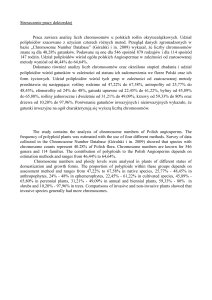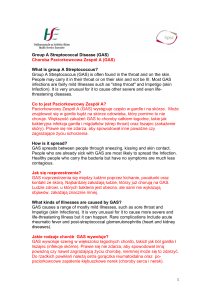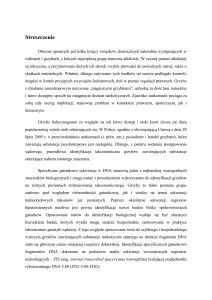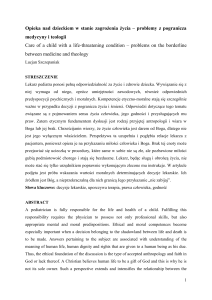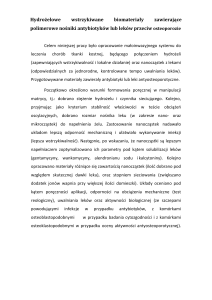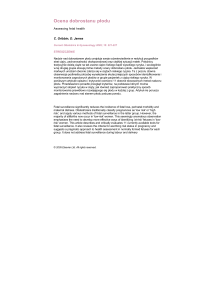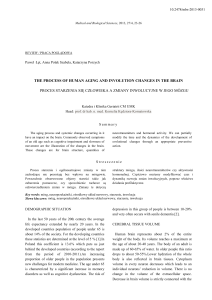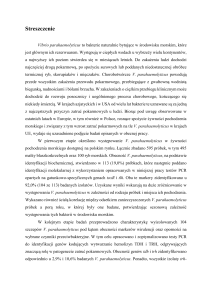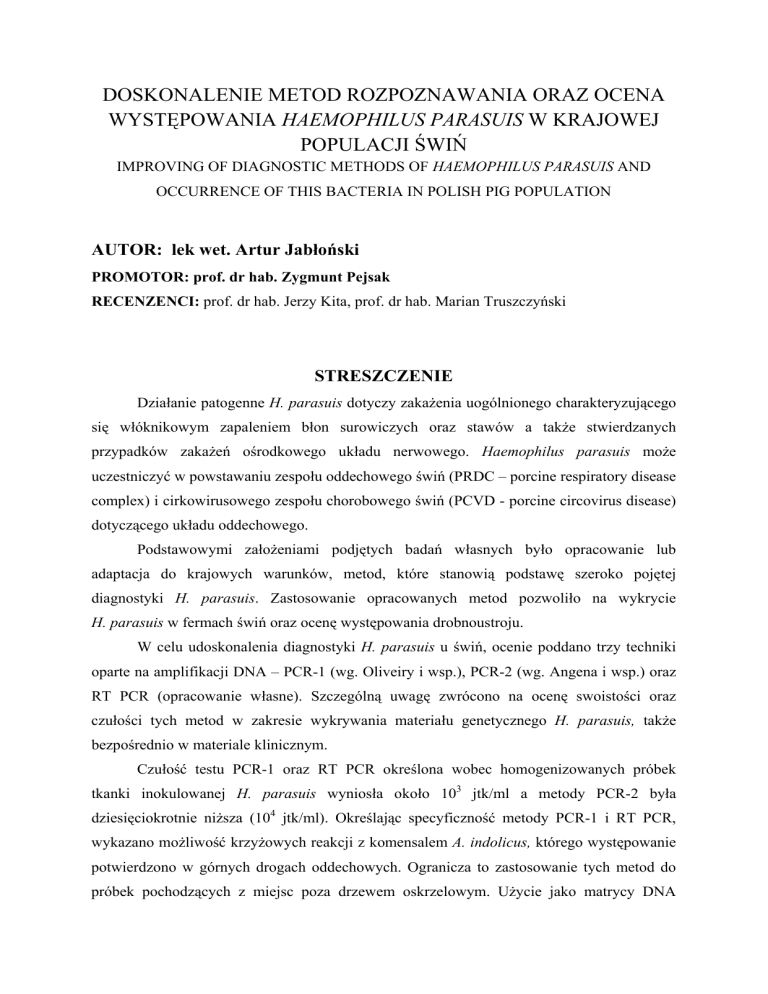
DOSKONALENIE METOD ROZPOZNAWANIA ORAZ OCENA
WYSTĘPOWANIA HAEMOPHILUS PARASUIS W KRAJOWEJ
POPULACJI ŚWIŃ
IMPROVING OF DIAGNOSTIC METHODS OF HAEMOPHILUS PARASUIS AND
OCCURRENCE OF THIS BACTERIA IN POLISH PIG POPULATION
AUTOR: lek wet. Artur Jabłoński
PROMOTOR: prof. dr hab. Zygmunt Pejsak
RECENZENCI: prof. dr hab. Jerzy Kita, prof. dr hab. Marian Truszczyński
STRESZCZENIE
Działanie patogenne H. parasuis dotyczy zakażenia uogólnionego charakteryzującego
się włóknikowym zapaleniem błon surowiczych oraz stawów a także stwierdzanych
przypadków zakażeń ośrodkowego układu nerwowego. Haemophilus parasuis może
uczestniczyć w powstawaniu zespołu oddechowego świń (PRDC – porcine respiratory disease
complex) i cirkowirusowego zespołu chorobowego świń (PCVD - porcine circovirus disease)
dotyczącego układu oddechowego.
Podstawowymi założeniami podjętych badań własnych było opracowanie lub
adaptacja do krajowych warunków, metod, które stanowią podstawę szeroko pojętej
diagnostyki H. parasuis. Zastosowanie opracowanych metod pozwoliło na wykrycie
H. parasuis w fermach świń oraz ocenę występowania drobnoustroju.
W celu udoskonalenia diagnostyki H. parasuis u świń, ocenie poddano trzy techniki
oparte na amplifikacji DNA – PCR-1 (wg. Oliveiry i wsp.), PCR-2 (wg. Angena i wsp.) oraz
RT PCR (opracowanie własne). Szczególną uwagę zwrócono na ocenę swoistości oraz
czułości tych metod w zakresie wykrywania materiału genetycznego H. parasuis, także
bezpośrednio w materiale klinicznym.
Czułość testu PCR-1 oraz RT PCR określona wobec homogenizowanych próbek
tkanki inokulowanej H. parasuis wyniosła około 103 jtk/ml a metody PCR-2 była
dziesięciokrotnie niższa (104 jtk/ml). Określając specyficzność metody PCR-1 i RT PCR,
wykazano możliwość krzyżowych reakcji z komensalem A. indolicus, którego występowanie
potwierdzono w górnych drogach oddechowych. Ogranicza to zastosowanie tych metod do
próbek pochodzących z miejsc poza drzewem oskrzelowym. Użycie jako matrycy DNA
uzyskanego z homogenizowanych próbek tkanki inokulowanej H. parasuis w metodzie RT
PCR, ujawniło niesatysfakcjonującą liniowość reakcji (R2= 0,954), która uniemożliwia
zastosowanie metody do oceny ilościowej H. parasuis.
Analiza porównawcza metody bakteriologicznej opartej na izolacji i metod
molekularnych, które zastosowano do wykrywania materiału genetycznego H. parasuis
bezpośrednio w próbkach materiału klinicznego wskazuje, że metody molekularne
charakteryzowały się znacznie większą sprawnością w tym zakresie. Otrzymane wyniki badań
wykazały, że w większości przypadków, metoda PCR była jedyną metodą zdolną wykryć
obecność drobnoustroju.
Z 212 próbek pobranych z 148 gospodarstw średnio i wielkotowarowych
występowanie H. parasuis w zmianach wielonarządowych stwierdzono w 22 gospodarstwach
(14,86%). W większym odsetku gospodarstw - 26,14% (23 z 88 ferm) stwierdzono
występowanie H. parasuis w zmienionych zapalnie płucach (bronchopneumonia).
Obserwacje własne dotyczące określania przynależności serotypowej w zależności od
miejsca izolacji szczepów wskazują, że dostarczać one mogą informacji odnośnie zjadliwości
szczepów H. parasuis. Dotyczy to zwłaszcza serotypu 5., 1. i 13., które izolowane były
wyłącznie ze zmian patologicznych co świadczy o ich zjadliwości.
W niniejszej pracy, do oceny przynależności serotypowej metodą IHA wykorzystano
52 szczepy H. parasuis z różnych części Polski. Zaobserwowano, że wśród polskich izolatów
dominują serotypy 4. a następnie 13., 1. i 15. Stwierdzono tylko dwa szczepy (3,85%)
należące do serotypu 5. uważanego za wysoce zjadliwy. Zaobserwowano także obecność
dużego odsetka szczepów nie poddających się typowaniu (17,3%).
Do oceny zdolności różnicujących szczepów H. parasuis wybrano następnie dwie
techniki molekularne, które ze względu na wysokie koszty określania przynależności
serotypowej mogą stanowić alternatywę w typowaniu izolatów. Wybrano 2 techniki
różnicujące: ERIC PCR i PCR/RFLP. Pierwsza z omawianych technik genotypowych ERIC
PCR, charakteryzowała się wysoką zdolnością różnicującą szczepów H. parasuis pozwalającą
na uzyskanie wartości indeksu D na poziomie 0,988 co przekłada się na wysoką użyteczność
zastosowanej metody. Technika ta była łatwa do zastosowania, cechowała się niskim
kosztem, a czas potrzebny do uzyskania wyniku był stosunkowo krótki. Opracowana w pracy
metoda PCR/RLFP charakteryzowała się mniejszą od ERIC-PCR zdolnością różnicującą była
równocześnie bardziej pracochłonna i kosztowna. Jednak zaletą metody PCR/RFLP jest
większa od metody ERIC PCR powtarzalność.
SUMMARY
Pathogenic action of H. parasuis refers to the systemic infection characterised by
polyserositis and joints inflammation, as well as some found cases of central nervous system
infections. Haemophilus parasuis may be involved in the emergence of porcine respiratory
disease complex (PRDC) and porcine circovirus disease (PCVD) referring to the respiratory
system.
The basic thesis of the undertaken research were the development or adaptation to
national conditions, the method that form the basis of a broader H. parasuis diagnostic.
Application of the undertaken methods allowed to detect H. parasuis in pig farms and to
assess prevalence of micro-organism.
In order to improve the diagnosis of H. parasuis in pigs, three techniques were
evaluated, all based on the DNA amplification - the PCR-1 (acc. Oliveira et al), PCR-2 (acc.
Angen et al) and RT PCR (own). Particular attention was paid to the evaluation of specificity
and
sensitivity
of
these
methods
in
terms
of
detecting
genetic
material
of
H. parasuis but also directly in clinical specimens.
The PCR-1 and RT PCR sensitivity tests referred to the homogenised samples of H.
parasuis inoculated tissue amounted to approx. 103 CFU/ml whereas the sensitivity result of
the PCR-2 method was ten times lower (104 CFU/ml). The process of determining the
specificity of the PCR-1 and RT PCR methods demonstrated the possibility of cross-reaction
with A. indolicus commensal, which existence was confirmed in the upper respiratory tract.
This limits the application of these methods to samples originating from areas outside
bronchial tree. The use of DNA as a matrix obtained from the homogenised samples of H.
parasuis inoculated tissue in the RT PCR method revealed the unsatisfactory linearity
reaction (R2 = 0.954), which prevents the application of the method for quantitative
assessment of the H. parasuis.
Comparative analysis of the bacteriological method based on isolation and molecular
methods, which were used to detect the genetic material of H. parasuis directly in the samples
of clinical material, indicates that the molecular methods were characterised by a much
greater efficiency in this regard. The obtained test results proved that in most cases, the PCR
method was the only method able to detect the presence of micro-organism.
From 212 samples collected from 148 medium and large farms the presence of
H. parasuis in systemic changes were found in 22 farms (14.86%). Greater percentage of
farms - 26.14% (23 out of 88 farms) identified the presence of H. parasuis in the
bronchopneumonia lung samples.
In this research, 52 strains of H. parasuis from different parts of Poland were utilised in
order to evaluate the affiliation of serotypes by IHA method. Own observations regarding the
determination of serotypes affiliation depending on the isolation of strains indicate that they
can provide information on pathogenic strains of H. parasuis. This refers especially to
serotypes 5., 1. and 13., which were isolated solely from lesions reflecting their virulence.
It was observed that among Polish isolates the predominant serotypes are: 4. followed
by 13., 1. and 15. It was established that only two strains (3.85%) belonged to serotype 5.,
serotype which is considered as highly virulent. The presence of a large proportion of
nontypable strains (17.3%) was also observed.
In order to assess the discriminatory power of the H. parasuis strains two molecular
techniques were selected, which, taking into consideration the high costs of determining the
serotypes affiliation, may constitute an alternative method in typing of isolates.Two
discriminatory techniques were selected: ERIC PCR and PCR/RFLP. The first of the
described genotyping techniques ERIC PCR was characterised by high discriminatory power
of the H. parasuis strains allowing obtaining the index of D at the level of 0,988, which
translates into a great effectiveness of the adopted method. The above technique was
straightforward to use, characterised by low cost, and the timeframe required to obtain a result
was relatively short. The undertaken PCR/RLFP method in the research had less than ERICPCR discriminatory power was also more labor intensive and costly. The great advantage of
the PCR/RFLP over the ERIC PCR method however is higher repeatability.

